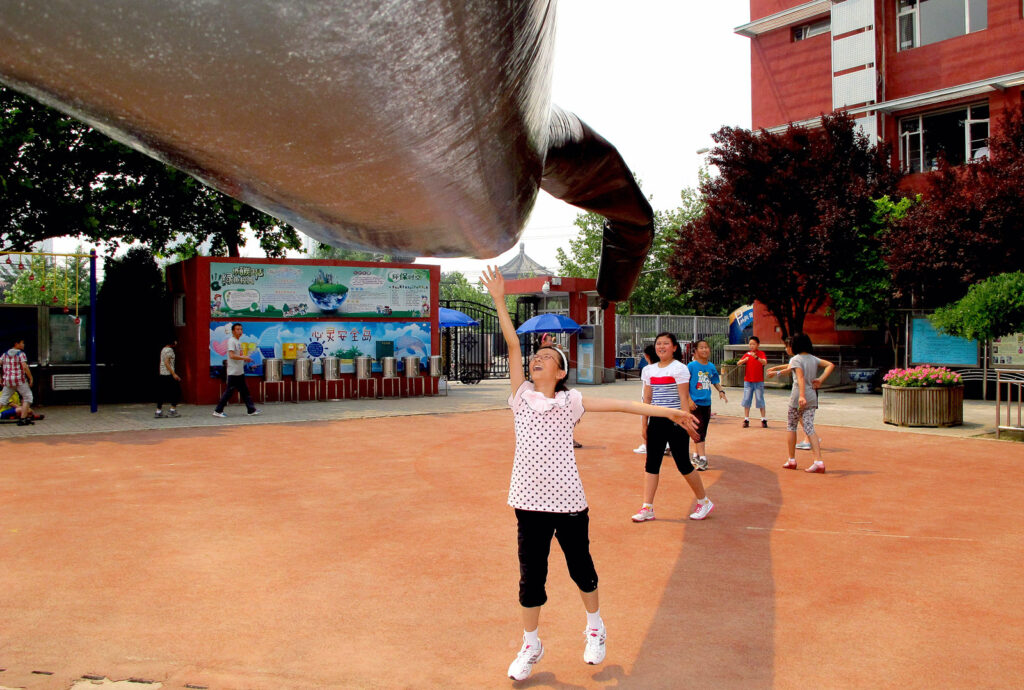By Otak Jump
What image is conjured by the term Chinese classroom? Forty or fifty students lined up in rows each doing the same lesson while the teacher stands in front. We found those classrooms this summer when we visited two elementary schools in Beijing and Shenzhen. But we also found a spirit in the Chinese teachers, students, and leaders that was quite at odds with the stereotype. In fact, we found a readiness to embrace new methods including project-based learning.
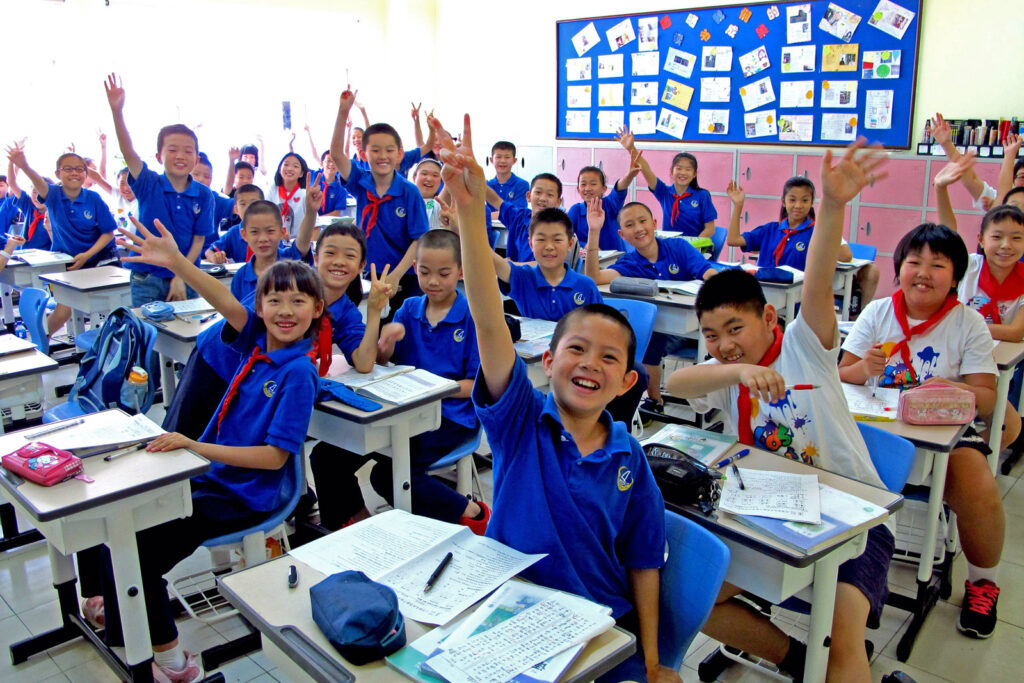
We had been invited to participate with four other American elementary schools in the First Annual International Conference on Elementary Education. Each school was assigned a Chinese counterpart in Beijing and later in four other sites: Dalian, Chengdu, Chongqing and Shenzhen. In this article I will describe some revealing moments of our experience and why we plan to return next summer to continue our collaboration.
We were invited to come to China by scholars at Beijing Normal University, which is primarily a teacher training college. What we were to present was vague, but the goal was to introduce some innovative American methods to Chinese schools by teaching demonstration lessons and by direct lecture/presentation. My former principal, Susan Charles, was invited by Stanford Center for Assessment, Learning and Equity and she in turn added me to the team.
Our introduction to each of the two schools where we taught was via Face Time. There was a window of time, Sunday evening for us, Monday morning for them, when we could talk. At first, we said hello individually to the students. Each had a rehearsed script; some were able to respond to questions in English. Later we talked to the principals and leaders who wanted to know what we planned to say so that the text could be translated. As we got closer to the actual date, the anxiety grew from the Chinese, particularly when we informed them that we often spoke extemporaneously and embellished with stories. However, we both knew that the goal of sharing teaching practices would be lost if we did not help each other look good to the observing governmental agencies.
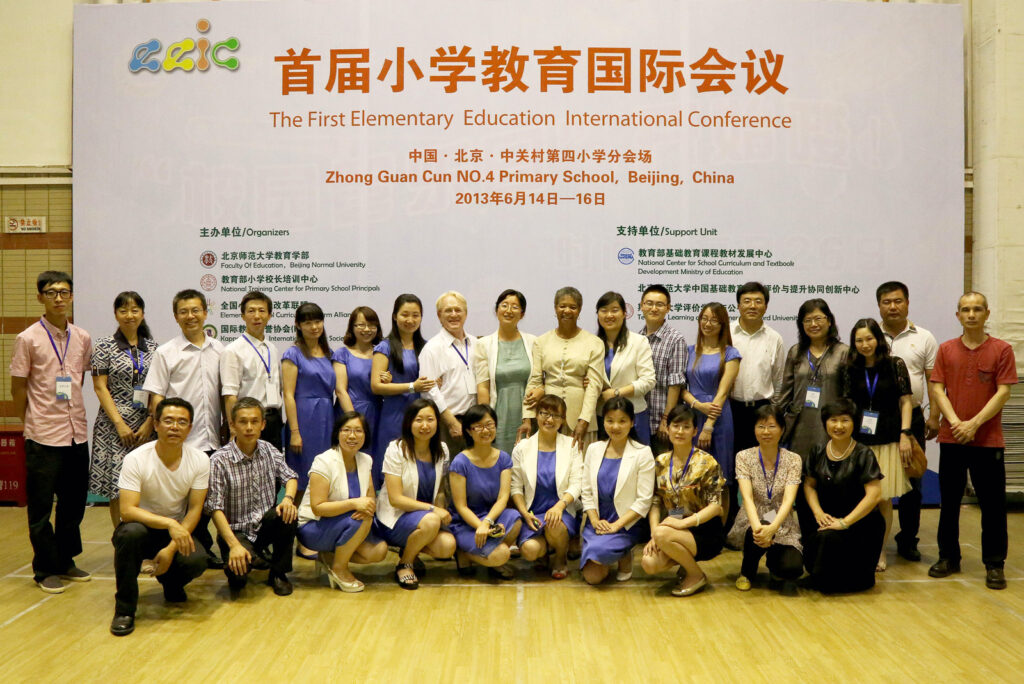
The school where I teach, Ohlone Elementary in Palo Alto, CA has several features that were new to Chinese, and many American, schools. We do not give grades to students that would compare them to each other, we do not issue report cards enumerating standards met or missed, we do not give regular homework, there are no bells. We started the sharing with a talk about our school’s core values: trust and respect for each individual, a developmental approach to learning, formative assessment, meaningful relevant curriculum, multidimensional learning, cooperation and collaboration, teacher-parent-student partnership. We were met with the core values of Beijing Zhonguancun#4: everyone matters, everyone works, everyone changes. Immediately we knew that we were working with partners in spirit.
The leaders at Zhongguancun#4 Elementary School had given up their one air-conditioned staff room to create what they termed an “Ohlone-style” classroom. In fact, it was better than any room we actually have at our home school. Desks and stools were light and easily moved to configure the room for whole group presentation, small group work, or individual study. The room was spacious and even featured a rug and couch. While most classes at the school had forty or more students, we were given twenty-five, most of whom could speak English well enough that I could teach without an interpreter.
When I first met the students, we sat in a circle on the fuzzy carpet. I had no plan, but wanted to respond to the moment. The students sat with the boys on one side and the girls on the other. I asked them what they noticed about how they were sitting. They did not pick up on the gender divide, so I pointed it out and told them I would teach them a new word: integration. I then gave them ten seconds to make a change. With typical kid energy, they moved around until the boys and girls had switched sides, but were still segregated. I gave them five seconds for a second chance and they moved into clumps; a third try of three seconds and they were laughing and slightly more integrated. Then I taught them a song, Make New Friends, but Keep the Old, which we were able to sing as a round. They sang beautifully and had clearly decided that this old American might be fun to work with.
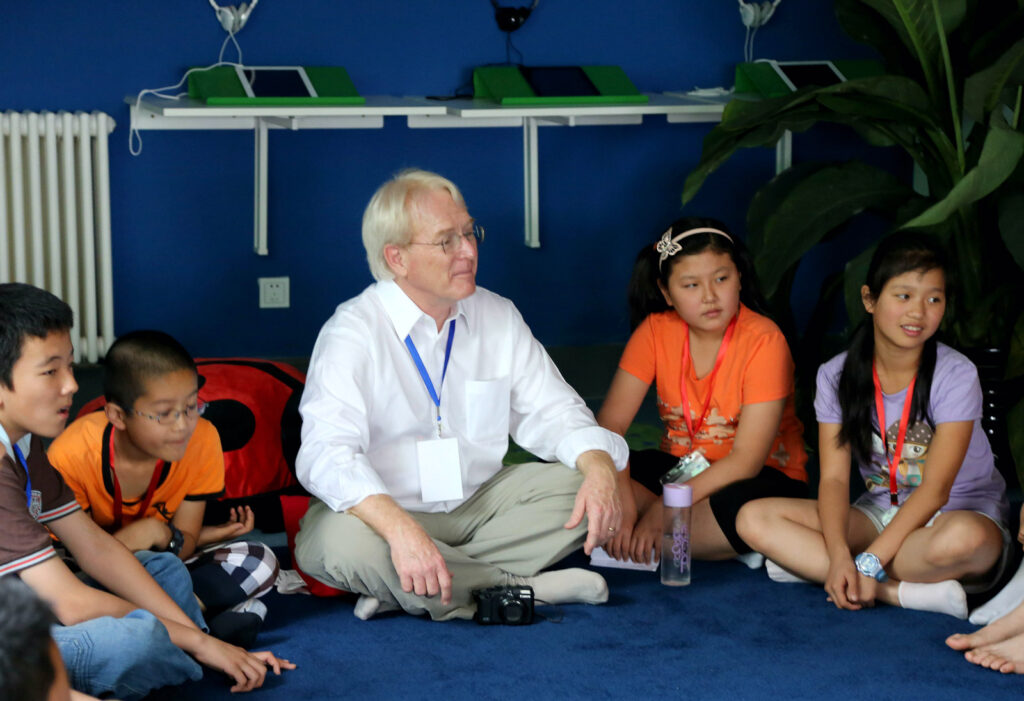
I taught two formal lessons, but because the sessions were to be observed via video in the lecture hall below, I had to make some modifications. I had ordered a load of teaching toys from one of our sponsors, NASCO, that allowed the students to show principles of solar energy, using both photovoltaic cells and water heaters. We needed to use these toys in the sunlight, so we decided to make a video we could show during the demonstration lesson the next day. The technical crew was on it, ready with a camcorder. The students played with solar cells, water heaters, solar cars, and even a twenty-foot long solar balloon. Everyone was engaged and the students were ready for the lesson. The video was beautifully shot and edited.
I was impressed by the level of technology available at our host school. I wondered if the situation had been reversed if my elementary school could have marshaled the hardware and expertise to broadcast the lesson in another hall and project our talks on three huge separate screens. At one point I forgot that YouTube is blocked in China and had planned a lesson that featured a video. One of the teachers managed to find a copy online and copied it to my flash drive.
The next day, I introduced the solar house project with a power point slide show I had created with the help of the Rahus Institute. The idea was simple: use tagboard, tape and scissors to build a scale model house that used principles of passive solar heating and cooling, as well as solar water heating and photovoltaics. We did not, unfortunately, have time in a single lesson to construct the model. The task I gave the students was to describe the solar toys they had played with the day before and imagine how they might be used in a model they could construct in the future. They put their information on chart paper and then had to present to the whole group.
I allowed the students to create their own groups, however, they had to be gender integrated. Borrowing a strategy I read in Tony Wagner’s The Global Achievement Gap, I told the students that only one or two members of the group would present and that I would choose the presenters. When asked what that meant, they realized that all members of the group would have to have a clear understanding of the concepts involved and have the requisite language to explain their poster.
I found that the students were fundamentally the same as the ones I work with in the United States. Perhaps knowing them for a longer time would have revealed some subtle differences, but working with them was remarkably familiar and the students were engaged and cooperative, while still being boisterous kids. They did not seem to notice or be affected by the pubic nature of the classroom experience. This was true in Beijing, where the lessons were sent by video to a larger audience downstairs, and in Shenzhen, where the audience sat in the same room and even moved among the students while they worked.

After teaching, we presented our talks to the adult group. This consisted of professors from the university, teachers from across China, and American guests: administrators, board members, and university researchers. My principal talked about schooling by design and habits of mind. I spoke about project-based learning. Both talks were well received, particularly given the fact that they occurred in stifling heat at the end of a long day.
The next day I taught a math lesson. It began with the classic video, The Powers of Ten. We then discussed exponents and I selected several large numbers for them to consider: 102, 104, 106, and 109. I asked them to think about things in the room that would be counted by hundreds (books), thousands (pages), millions (hairs on their heads). Their task was to find, again in small groups, things that could be counted by these large numbers. There were some debatable answers, but everyone agree there were 24 million residents of Beijing and 7 billion people on planet Earth. (I didn’t ask them to consider the national debt of the U. S., which would, of course, have taken us into the trillions.)
Susan and I added a final twist to our teaching experience. At Ohlone, all 4-5 classes have buddies at both the K-1 and 2-3 levels. (All classes at Ohlone are multiage by design.) Buddies give students a chance to share their work cross-age as well as giving students friends on the playground. We asked the Chinese children to do the same thing. They shared what they had learned in their lessons with each other. We asked them to make a commitment to find their buddies on the playground and at least say hello. Of course, we taught them a song to sing together. Finally our class looked more like a standard Chinese class; there were fifty students, but they sat in a circle.
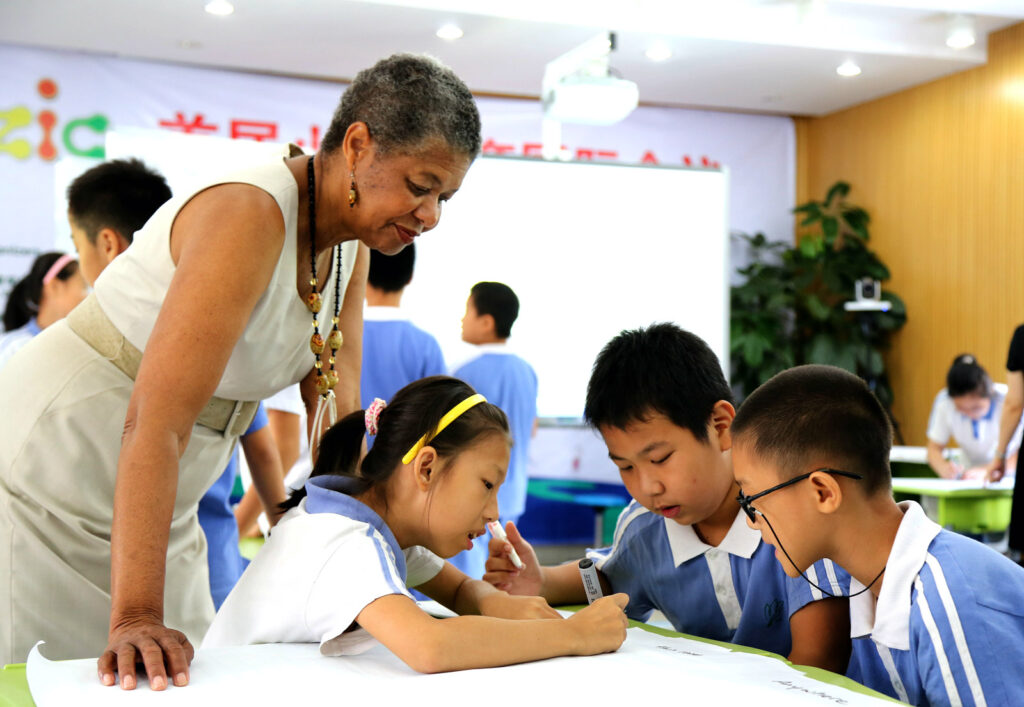
Two events were unexpected and they happened at the very end of our visit during the question and answer session at Nanyou School in Shenzhen. First, the conference was packed and the final sessions went late, long past the normal dinner hour. I expected most participants to call it a day and leave us with a rather small crowd. But hardly anyone left. Even in Beijing where the room was stiflingly hot, a determined crowd wanted to hear what we had to say and interact with us individually after the talk.
Second, the last question in Shenzhen was about homework and how it fit with our philosophy of educating the whole child. I responded that we don’t give homework at our school, although many children often work at home either because they have a project to finish or because they are truly interested in the subject and don’t want to stop learning just because school is over for the day. I added that kids need to spend time with their families in the evening, not just study until they go to bed. The applause was spontaneous and loud. Just as in the United States there is a realization that high stakes testing is not just killing students’ love for learning, it is also ruining family time. The Chinese see that what they give up to promote the education of their child (children doesn’t seem the right term in light of the one-child policy) may actually separate them from the precious life they strive so hard to protect and promote.
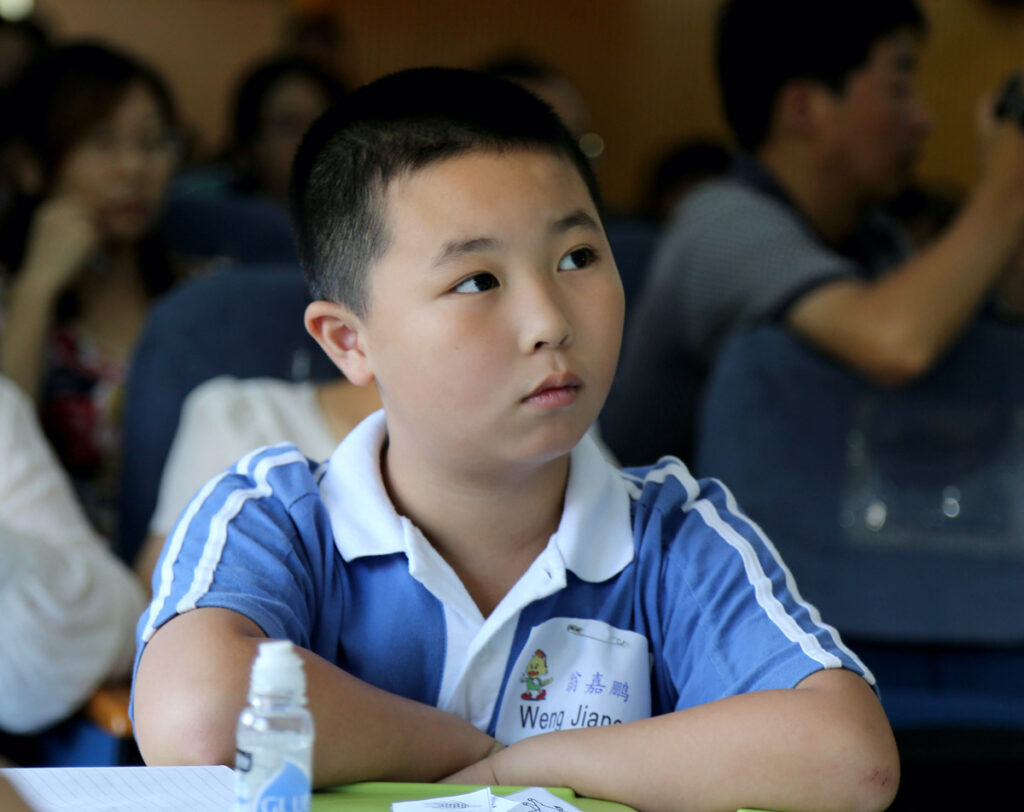
We left Beijing and Shenzhen was a strong desire to return. The friendships we made were authentic and based on our desire as educators to speak strongly to the whole child. We hope that the “annual” in the title of our conference is real. But next time for a week in each school. Mornings would be for the children, to try and complete a focused and scaled project. Afternoons for the teachers, to help them plan their next unit to try to incorporate some of the principles of student-centered or project-based learning into their teaching lives.
While I rested from the experience with a few days of vacation in Hong Kong, I received an email from one of my Chinese colleagues. She wanted to write a manual for students to start projects in her school. I suggested she go over the general principles we had discussed, and then ask her students to write their own handbook. Make it relevant and possible to their own situation. I offered the services of my own students to take their English translation and edit it into idiomatic English. Both sides would profit from the experience, both academically and cross-culturally. Her response was enthusiastic. If only more schools in the United States were as eager to look beyond passing the test and truly committed to engaging all students through project-based learning.
